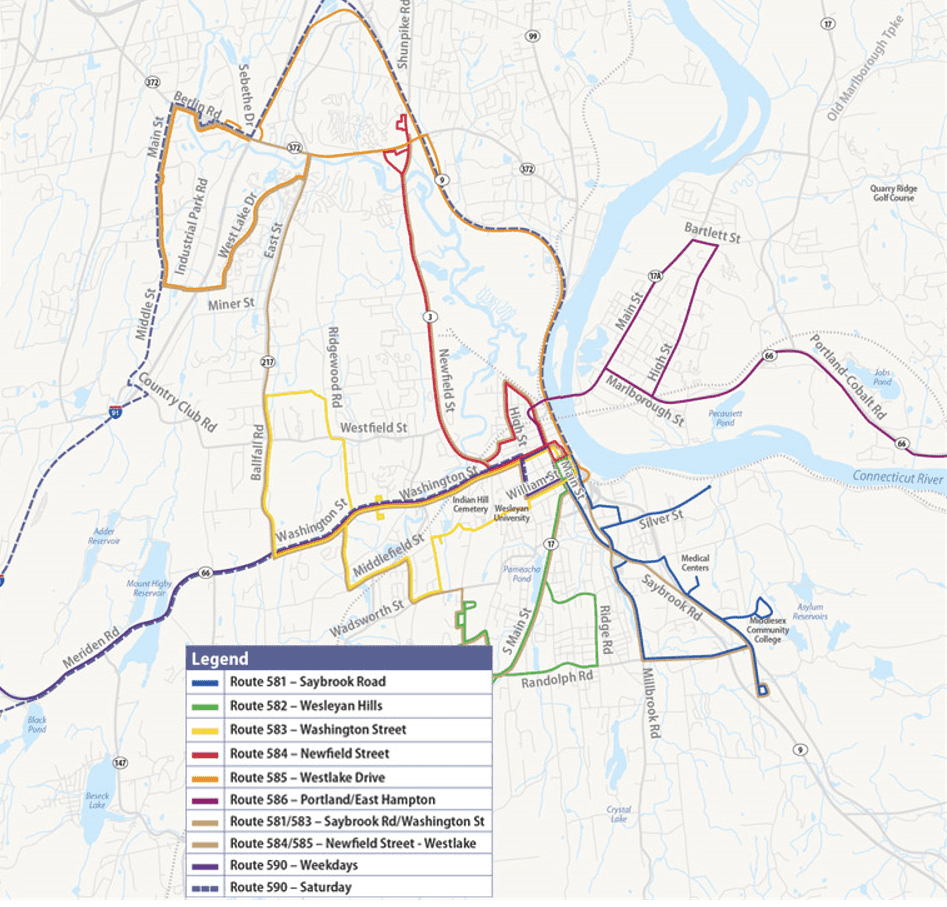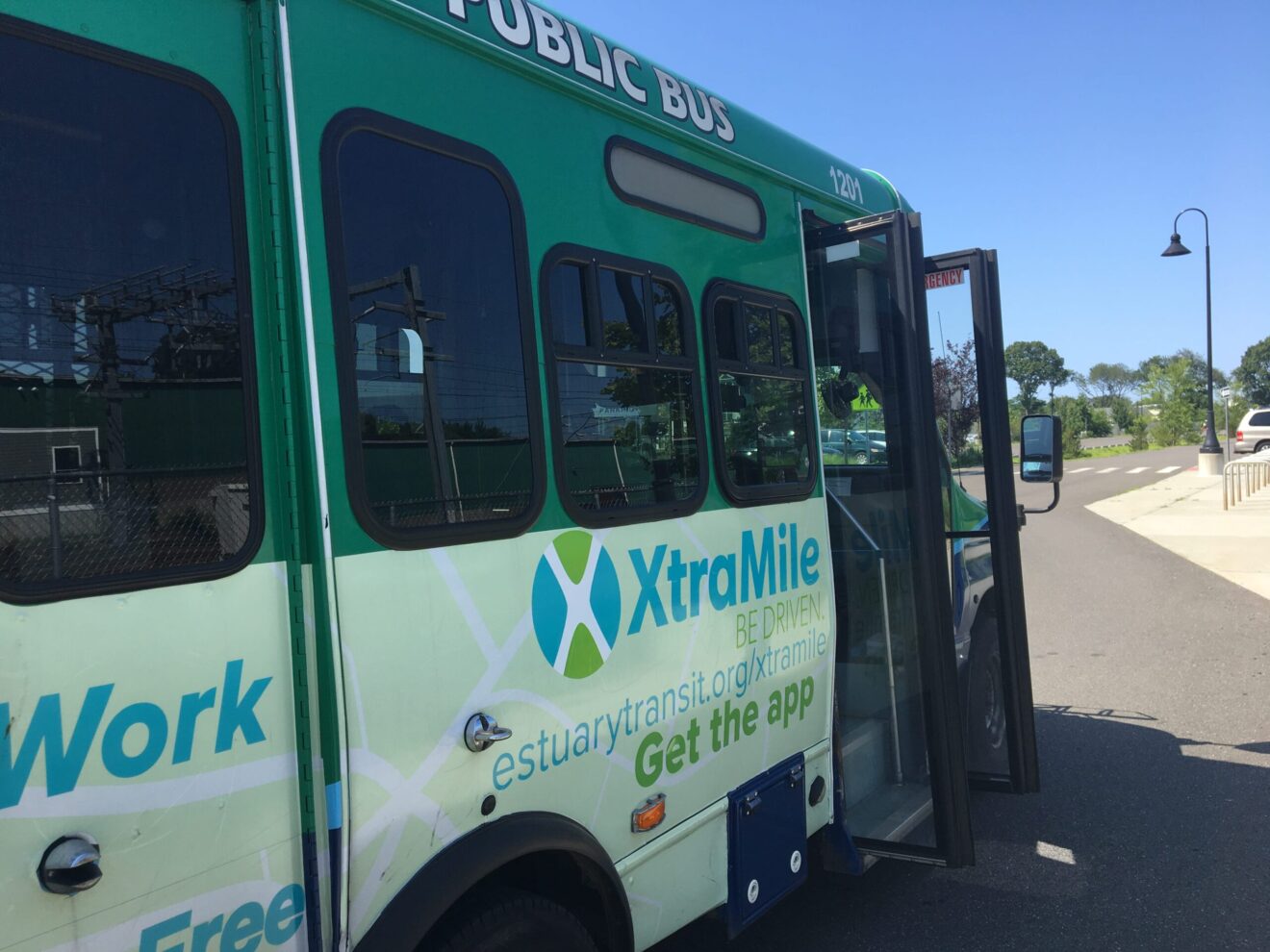After more than two years of deliberation and negotiation, a plan is nearly in place to combine Middletown Area Transit with 9 Town Transit into a single district.
The agreement is intended to provide the separate, smaller transit districts with additional financial stability. A combined district also feeds hopes of expanded bus service across Middlesex County connecting rail and bus lines in southeastern Connecticut with the Hartford and New Haven areas.
Durham First Selectman Laura Francis, who serves on the boards of both transit districts, said the consolidation addresses the reality that small transit districts are not sustainable in the long run.

“Fixed costs are what they are, rates can only be increased so much, and finding efficiencies, sharing facilities, et cetera – it just makes so much sense,” Francis told CT Examiner.
The two districts are already linked, and they have a history of consolidating services when it makes sense – notably by consolidating the Connecticut River Estuary and Midstate regional planning organizations into the Lower Connecticut River Valley Council of Governments [River COG], which in turn commissioned the study that developed into the plan to consolidate the two transit districts.
“For many years, even prior to this merger, Durham has benefited from some of the services of 9 Town Transit, particularly the on-demand service,” Francis said. “The ‘9 Town’ name is already a little bit obsolete, because there’s about 13 of us that are utilizing some services of 9 Town.”
One possibly significant efficiency would come in the form of a new maintenance facility planned across the street from the existing maintenance garage at the corner of Pease Avenue and North Main Street in Middletown’s North End. Currently, both districts contract out the majority of their maintenance work.
According to 9 Town Transit Executive Director Joe Comerford, there are few garages in the region that have the expertise to work on the buses, and that while the mechanics they work with have been good partners, their availability can be a problem, and the existing garage in Middletown only has one bay and the capacity to work on one bus at a time.
Without any in-house maintenance, Comerford said, something as simple as a headlight that burns out can take a bus out of commission for a day if a contracted mechanic can’t come in right away. With an in-house crew, a larger facility in Middletown, and a smaller facility on the shoreline for smaller maintenance jobs, those problems would be resolved, said Comerford.
The other primary efficiency comes from the combined district being able to support a more robust administrative staff, allowing individual staff members to specialize in the positions that navigate the complicated and always-changing federal transit bureaucracy, Comerford said.
“The rules get more onerous every year, so another part of it is making sure we are complying with all the regulations,” Comerford said. “It’s hard to have a purchasing person with a 20-bus fleet, but for a 40-bus fleet you can justify having that position, so you’re not just relying on a few staff who know everything.”

Sam Gold, executive director of RiverCOG, said there is a history of small transit districts running into financial trouble. In 2017, the Middletown Area Transit district faced major service cuts, or even closure, when a dip in state funding put its already precarious finances in disarray.
With a small staff Gold said, the system relies on having the right people who can handle every responsibility. In general, smaller districts run on a “shoestring” budget, where one thing going wrong can disrupt the whole system.
“You don’t want an organization to be so reliant on one or two people,” Comerford said, partly summarizing the findings of a transit study completed by RiverCOG in 2019. “Certainly a factor was not knowing how to properly allocate funding between grant programs. And it’s complex, when you’re dealing with state and federal funds – it’s complex.”
The combined district – which would have about 40 buses and a pre-COVID ridership of about 400,000 passenger trips a year, putting it about in line with other mid-sized transit districts like the Southeast Area Transit District that serves the Norwich-New London areas – would be able to hire more specialized staff, and would hopefully be better positioned to keep more junior employees around longer and build institutional knowledge, instead of watching people leave for larger transit districts, Comerford said.
Westbrook First Selectman Noel Bishop, who serves on the 9 Town Transit board, said the consolidation is not just about financial stability – 9 Town hasn’t had financial issues in almost a decade, he said. It’s about expanding service, something he said is crucial to the economy of the area the district serves.
Transportation and affordable housing are the two significant challenges for the area’s economy, Bishop said, and they are linked. School enrollments are down because families aren’t able to afford homes in Westbrook or Essex or Guilford, he said. If they are stretching to pay their mortgage or rent, they might not be able to also afford a car to get to work, said Bishop.
Added services
“9 Town Transit is opening up all kinds of transportation opportunities that we would not normally have,” Bishop said. “And people need help, they can’t all afford to drive cars.”
Comerford said Middletown’s ridership is still down about 40 percent from pre-pandemic numbers, and 9 Town Transit is down about 25 to 30 percent.
One service that has continued to increase its ridership despite the pandemic is the Xtra Mile service 9 Town Transit rolled out in Old Saybrook and Essex in 2019 – though Comerford said that could simply be because people are still learning about the relatively new, currently free, ride-sharing service.
Still, Comerford said he is optimistic about the future of that service, and has applied for funding from the Connecticut Department of Transportation to expand it to other areas that the combined district would serve – particularly in Middletown. It’s one of a “laundry list” of ideas for expanded service for which they have asked the department for funding.
The district is also looking to bring back service on Sunday, considering so many people use transit to get to service sector jobs, and they still need to get to work on Sunday. It’s also looking to better align connections with other transit districts to limit the time people have to wait for a transfer – which is a particular issue for the riders who use 9 Town transit to get from Middletown to New London, who often have long waits for a connection in Old Saybrook.
“Our real goal is to be able to have a fare system that works with everybody who we connect to, which for this combined transit system is Southeast Area Transit and four CT Transit lines – New Haven, Meriden, New Britain and Hartford – and CT Rail and Shoreline East,” Comerford said. “That’s our possibly overly-ambitious goal, is to have a fare system that works for all of them and can make it as easy as possible for our customers.”
Those plans for service expansions are dependent on more funding coming from the state department of transportation, which is not guaranteed. But even without those changes, area leaders see the consolidation as a positive step to keep the buses running into the future.
“This is an exciting opportunity, and I think it’s a good model of how small transit districts can work together and find a future together that ends up being more beneficial to the riders,” Gold said. “It’s a good model for other parts of Connecticut that are served by multiple small transit districts. This is a good test case.”

